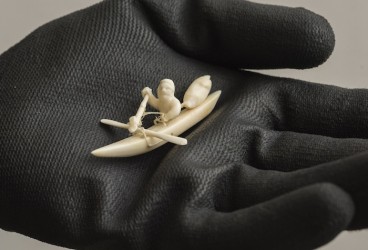Article Origin
Volume
Issue
Year
The Winnipeg Art Gallery has welcomed an exciting new collection into their midst. The Government of Nunavut has donated a huge number of archived materials to put on display at WAG, and staff at the gallery are busy unpacking and cataloguing the material, while trying to find where it all will go.
“It’s not an exhibit, but will be used for an exhibit in the future… It’s almost 8,000 pieces, and it’s been in the north for decades,” said Inuit Curator Darlene Coward Wight. She said there were things in storage all over the place so they decided to send them to Winnipeg on a five-year loan. "We’re really excited,” she said.
Caption: Hunter in Kayak by carver Bernadette Iguptark Tongelik (Repulse Bay) is just one piece of almost 8,000 artworks from the Government of Nunavut art collection currently on loan to the WAG.
Photo by David Lipnowski
According to Wight, the works were scattered across at least three different provinces and territories, as a result of Nunavut’s split in 1999 from the Northwest Territories. The art is the product of around 800 individual Nunavut artists, and consists of prints, sculptures, drawings, paintings, and even a few items of clothing.
“There are some amazing contemporary works, and some very large scale pieces. Then there’s some early works… We don’t have that kind of material in our collection. There are things considered artifacts, and things they used in their day-to-day lives probably 100-years ago,” said Wight.
The goods travelled more than 6,000 kilometers in nearly 300 crates and boxes, and Wight said she’s been taking every opportunity to go downstairs and take a peek at freshly opened items.
One of her favorite pieces so far is a small stone statue of an archer made in the 1980s, which she saw once 30 years ago in a gallery in Ottawa. Another favorite is an ivory carving of a seal hunter sitting in a kayak with a spear, made in the 1950s.
“It’s very exciting to see pieces as they come out of boxes. It will fill holes in our collection, and will be available for research by other people,” she said.
And while WAG already has an extensive Inuit Art collection—the largest public contemporary Inuit Art collection in the world, in fact—the new collection will become part of an even larger Inuit Art Center in the process of being built now.
Their decision to document the new material further contributes to their ability to reach the pubic with their displays, but also serves as a way for the Government of Nunavut to keep better track of what they had in storage, said Wight.
“We are very busily putting it into our database, and taking photographs of every piece. Eventually this will all be available for people in the north to access visually (digitally), and the hope is that one day the Government of Nunavut will have its own Heritage Centre where these pieces can then go,” she said.
Director of Culture and Heritage for Nunavut, Doug Stenton, had a hand in the negotiation process between WAG and the Government of Nunavut. He believed that any shorter than a five-year period of having the collection at WAG would not have been sufficient.
“It’s five-years because there was a lot of effort by a lot of people to prepare for this. There’s a significant cost associated with that many pieces of art, so only a year or so wouldn’t be as cost effective, and wouldn’t allow for the programming and projects planned around the collection,” said Stenton.
He said some of the important information WAG is documenting while unpacking the items is the name of the artist, what they created, the material used, the subject matter, what the condition is, and whether it has been repaired in the past. From a collections management point of view, he said, it makes it easier to keep track of the items in the future.
“It’s an exciting opportunity to promote Inuit art and culture. I’m looking forward to the increased public accessibility, whether it’s digitized or through exhibitions that I know are being planned,” he said.
- 2251 views

